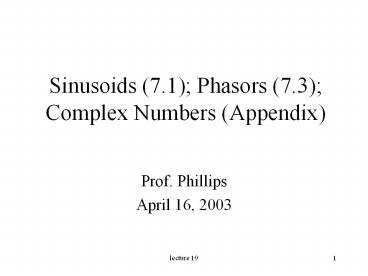Sinusoids 7.1 Phasors 7.3 Complex Numbers Appendix - PowerPoint PPT Presentation
Title:
Sinusoids 7.1 Phasors 7.3 Complex Numbers Appendix
Description:
On the preceding plot, which signals lead and which signals lag? lecture 19. 12. Class Examples ... A = x jy B = z jw. A B = (x z) j(y w) ... – PowerPoint PPT presentation
Number of Views:279
Avg rating:3.0/5.0
Title: Sinusoids 7.1 Phasors 7.3 Complex Numbers Appendix
1
Sinusoids (7.1) Phasors (7.3)Complex Numbers
(Appendix)
- Prof. Phillips
- April 16, 2003
2
Introduction
- Any steady-state voltage or current in a linear
circuit with a sinusoidal source is a sinusoid. - This is a consequence of the nature of particular
solutions for sinusoidal forcing functions. - All steady-state voltages and currents have the
same frequency as the source.
3
Introduction (cont.)
- In order to find a steady-state voltage or
current, all we need to know is its magnitude and
its phase relative to the source (we already know
its frequency). - Usually, an AC steady-state voltage or current is
given by the particular solution to a
differential equation.
4
The Good News!
- We do not have to find this differential equation
from the circuit, nor do we have to solve it. - Instead, we use the concepts of phasors and
complex impedances. - Phasors and complex impedances convert problems
involving differential equations into simple
circuit analysis problems.
5
Phasors
- A phasor is a complex number that represents the
magnitude and phase of a sinusoidal voltage or
current. - Remember, for AC steady-state analysis, this is
all we need---we already know the frequency of
any voltage or current.
6
Complex Impedance
- Complex impedance describes the relationship
between the voltage across an element (expressed
as a phasor) and the current through the element
(expressed as a phasor). - Impedance is a complex number.
- Impedance depends on frequency.
7
Complex Impedance (cont.)
- Phasors and complex impedance allow us to use
Ohms law with complex numbers to compute current
from voltage, and voltage from current.
8
Sinusoids
- Period T
- Time necessary to go through one cycle
- Frequency f 1/T
- Cycles per second (Hz)
- Angular frequency (rads/sec) w 2p f
- Amplitude VM
9
Example
- What is the amplitude, period, frequency, and
angular (radian) frequency of this sinusoid?
10
Phase
11
Leading and Lagging Phase
- x1(t) leads x2(t) by q-?
- x2(t) lags x1(t) by q-?
- On the preceding plot, which signals lead and
which signals lag?
12
Class Examples
13
Phasors
- A phasor is a complex number that represents the
magnitude and phase of a sinusoidal voltage or
current
14
Phasors (cont.)
- Time Domain
- Frequency Domain
15
Summary of Phasors
- Phasor (frequency domain) is a complex number
- X z ? q x jy
- Sinusoid is a time function
- x(t) z cos(wt q)
16
Class Examples
17
Complex Numbers
- x is the real part
- y is the imaginary part
- z is the magnitude
- q is the phase
imaginary axis
y
z
q
real axis
x
18
More Complex Numbers
- Polar Coordinates A z ? q
- Rectangular Coordinates A x jy
19
Are You a Technology Have?
- There is a good chance that your calculator will
convert from rectangular to polar, and from polar
to rectangular. - Convert to polar 3 j4 and -3 - j4
- Convert to rectangular 2 ?45? -2 ?45?
20
Arithmetic With Complex Numbers
- To compute phasor voltages and currents, we need
to be able to perform computation with complex
numbers. - Addition
- Subtraction
- Multiplication
- Division
21
Complex Number Addition and Subtraction
- Addition is most easily performed in rectangular
coordinates - A x jy B z jw
- A B (x z) j(y w)
- Subtraction is also most easily performed in
rectangular coordinates - A - B (x - z) j(y - w)
22
Complex Number Multiplication and Division
- Multiplication is most easily performed in polar
coordinates - A AM ? q B BM ? f
- A ? B (AM ? BM) ? (q f)
- Division is also most easily performed in polar
coordinates - A / B (AM / BM) ? (q - f)
23
Examples
- Find the time domain representations of
- V 104V - j60V
- I -1mA - j3mA
- at 60 Hz
- If Z -1 j2 ?, then find the value of
- I Z V

